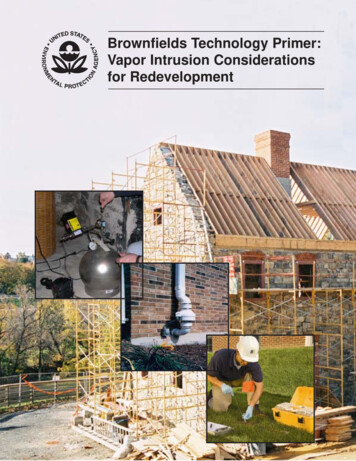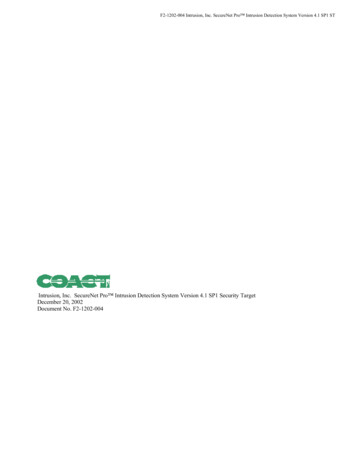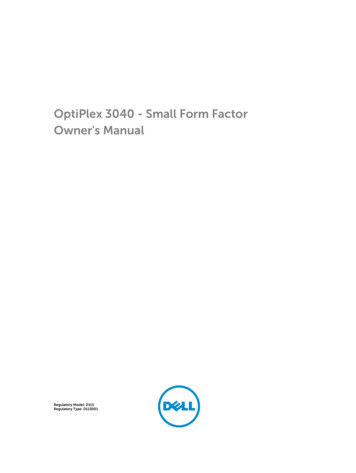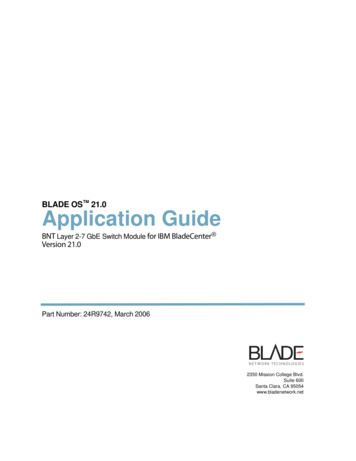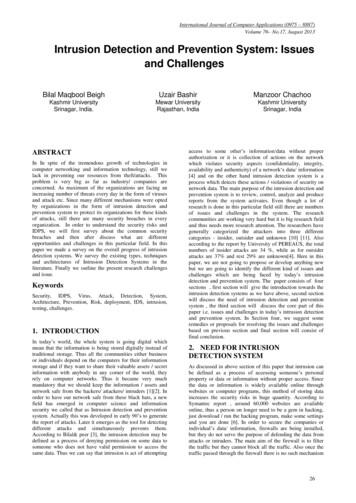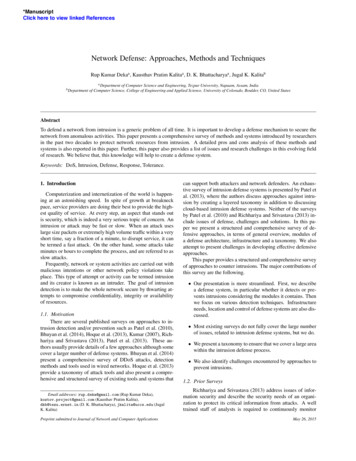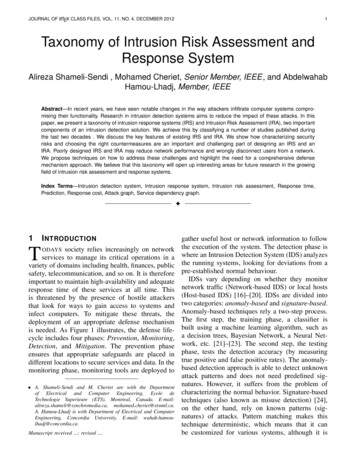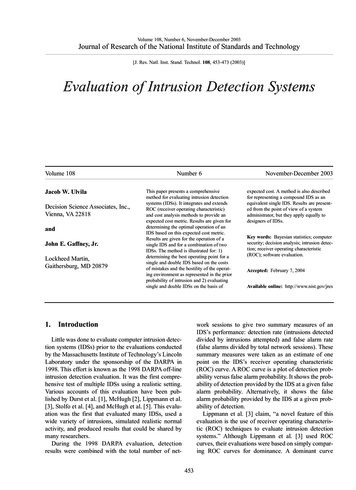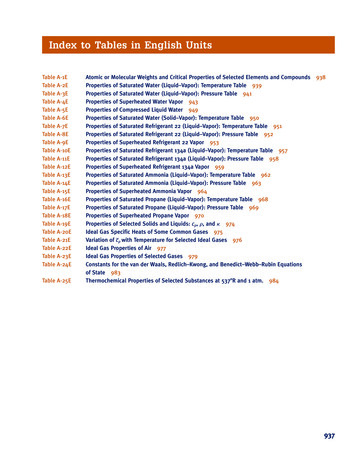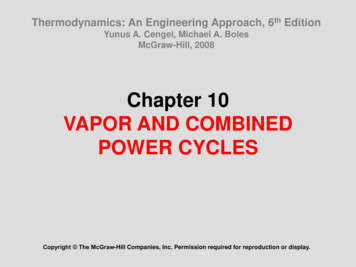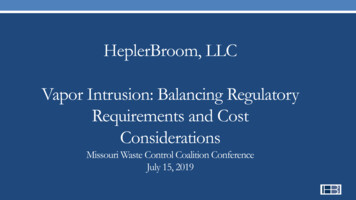
Transcription
HeplerBroom, LLCVapor Intrusion: Balancing RegulatoryRequirements and CostConsiderationsMissouri Waste Control Coalition ConferenceJuly 15, 2019
Vapor Intrusion“Vapor intrusion is the general term given to migration of hazardous vapors from anysubsurface vapor source, such as contaminated soil or groundwater, through the soil andinto an overlying building or structure. These vapors can enter buildings through cracks inbasements and foundations, as well as through conduits and other openings in the buildingenvelope. Vapors can also enter structures that are not intended for human occupancy(e.g., sewers, drain lines, access vaults, storage sheds, pump houses) though cracks andother openings.All types of buildings, regardless of foundation types (e.g., basement, crawl space, slab-ongrade), have openings that render them potentially vulnerable to vapor intrusion ”OSWER Publication 9200.2-154
Vapor IntrusionVapor forming chemicals mayinclude: VOCs, e.g., TCE and benzene Some semi-volatiles, e.g.,naphthalene Elemental mercury Some PCBs and pesticidesLook at your state definition!
USEPA Vapor Intrusion GuidanceOSWER Draft Guidance for Evaluating the Vapor Intrusion to Indoor Air Pathway from Groundwaterand Soil (November 2002)Superseded and replaced by:OSWER Technical Guide for Assessing and Mitigating the Vapor Intrusion Pathway from SubsurfaceVapor Sources to Indoor Air (June 2015) (OSWER Publication 9200.2-154) CERCLA, RCRA, Brownfields, or state agencies acting under CERCLA or RCRAauthorityandOSWER Technical Guide for Addressing Petroleum Vapor Intrusion at Leaking Underground StorageTank Sites (EPA 2015b)
Vapor Intrusion – Cost Implications Different investigative and sampling methods, e.g., soil gas and indoor air samplingIn some cases, more stringent cleanup levels, e.g., TCELess than straightforward application of VI guidance and/or regulations - ?Mitigation costs: Sub-slab or sub-membrane depressurization, vapor barriers, ventedraised floorsUnavailability of certain institutional controls, e.g., groundwater restrictions/ordinancesRestrictions on future use and constructionVI issues on off-site properties
State Approaches to Vapor IntrusionUSEPA’s VI Guidance is not legally binding on states, so states have flexibility to developtheir own vapor intrusion programs
Missouri Vapor Intrusion GuidanceHistory: 2006 MRBCA Guidance and Risk-Based Target Levels (RBTLs)May 2016 and January 2017: MRBCA Stakeholder Group MeetingsMay 23-24, 2018 and June 5, 2018: MDNR issues draft Vapor Intrusion Guidance andrevised draft MRBCA Guidance, including revised RBTLs.October 2, 2018: Deadline for public commentJanuary 22, 2019: MRBCA Stakeholder Group Meeting
Missouri Draft Vapor Intrusion GuidanceDraft VI Guidance includes separate provisions addressing: (1) Volatile petroleumhydrocarbon COC (includes BETX and TPH) and (2) Volatile non-petroleum COC.Evaluation of VI uses analytical data from: Groundwater, Soil gas, Sub-slab soil gas, andIndoor Air.SEPARATION DISTANCES for petroleum sitesHot issue basis for MRBCA RBTL for TCENo reopeners of closed sites, but Superfund/RCRA authority is available in unusualcircumstances. MDNR site-by-site review of TCE issues.
Missouri Draft Vapor Intrusion GuidanceMitigation Engineered Controls: vapor barriers, sub-slabdepressurization, sub-slab venting Institutional Controls: Activity and UseLimitations/Environmental CovenantsRemediation
Missouri Draft Vapor Intrusion GuidanceDraft VI Guidance explains that Environmental Covenants may be required for: Mitigation controls at sites with current buildings, such as vapor barriers, sub-slabdepressurization, sub-slab venting Institutional controls at sites with potential future buildings, such as: (1) vaporbarrier/mitigation system for future buildings, (2) additional investigation and reevaluation of risk prior to construction, or (3) prohibition on construction. Combination of approaches for sites with existing buildings and undeveloped areasMDNR anticipates an increased use of AULs and Environmental Covenants at sites withVI issues
Missouri Draft Vapor Intrusion GuidanceNext steps:1. Draft final VI Guidance and RBTLs will be issued for public comment 60 day public comment period MDNR will respond to public comments and finalize RBTLs, MRBCA and VI GuidanceVI Rulemaking Publication of Regulatory Impact Report and public comment period2.
Kansas Vapor Intrusion GuidanceKansas Vapor Intrusion Guidance (August 2016):http://www.kdheks.gov/ber/download/Ks VI Guidance.pdf Follows USEPA VI and ITRC Guidance No current plans to update VI GuidanceRisk Based Standards for Kansas (RSK Manual 5th Edition) (indoor air screening levels forresidential scenario)USEPA Regional Screening Levels (RSLs) or site-specific determinations
Kansas Vapor Intrusion GuidanceKansas VI Guidance includes screening approaches for Chlorinated vapor intrusion(CVI) and Petroleum vapor intrusion (PVI) Presence of preferential migration pathways Vertical and Lateral Separation Distances Vapor Intrusion Assessment ReportSites that do not screen out under the CVI/PVI screening protocols must evaluatepotential VI risks. A Conceptual Site Model (CSM) is preferred approach for VI siteevaluation Groundwater screening Near-slab/sub-slab soil gas samples Possible indoor air (difficult to interpret without other lines of evidence)
Kansas Vapor Intrusion GuidanceApproaches to prevention of VI: Source Control – groundwater contamination, soil gas migration Air Quality Mitigation – seal gross openings, vapor barrier, ventilation, sub-slabdepressurization systemsFuture Use and Risk Management Need for institutional controls/restrictive covenants evaluated on a site-by-site basis factors include COC and geology Vapor resistant construction methods Mitigation for new buildings “Active monitoring”
Illinois Indoor Inhalation RegulationsIllinois revised its Tiered Approach to Corrective Action Objectives(“TACO”) regulations in 2013 to incorporate the indoor inhalation pathway Regulations apply to LUST and Site Remediation Program (SRP) sites with contaminationfrom volatile organic chemicals listed in 35 Ill. Adm. Code 742, App. A, Table J No retroactive application or reopening of NFR Letters unless new site-specificinformation indicates a vapor intrusion problem No indoor air remediation objectives Separation distances apply at petroleum sites (but be aware of IEPA new requirement forinstitutional controls with use of separation distances, effective 3/1/2019)
Illinois Indoor Inhalation RegulationsDefault presumption within indoor air regulations means that institutional controls arealmost always required at vapor intrusion sites:Presence of a building with a full concrete slab-on-grade or a full concrete basement floorand walls is required when Tier 1 or Tier 2 remediation objectives are applied because theremediation objectives are based on the assumed presence of a full concrete slab-on-gradeor a full concrete basementCannot use standard engineered barriers, Highway Authority Agreements, groundwaterordinances to address the indoor inhalation exposure route
Illinois Indoor Inhalation Regulations35 Ill. Adm. Code 742, Subpart L recognizes four different types of BCT:Sub-slab depressurization systems (for buildings with slab-on-grade or basementfoundations)2. Sub-membrane depressurization systems (used mostly for existing buildings with crawlspaces but applicable to new construction)3. Membrane barrier systems (used for new construction)4. Vented raised floors (used for new construction)1.
Vapor Intrusion - Cost ConsiderationsSo my company is remediating a property withpetroleum and/or VOC contamination ØWhat is the applicable state VI program/guidance for this site?ØWhat are the requirements and associated costs for site investigation?Ø(Does my environmental consultant have VI experience?)ØWill mitigation be required for existing and/or future buildings?If, yes, what areoptions and costs?ØWill we have to accept institutional controls for my property? If yes, how will theseimpact our ability to sell the property?ØAre there potential off-site VI issues? If yes, how will these have to be addressed?
Vapor Intrusion - Cost ConsiderationsSo I am thinking about buying an impactedproperty Does the Phase I identify any potential VI issues?Ø(Does my environmental consultant have VI experience?)ØWhat is my consultant’s recommended strategy for investigation and evaluation of VIissues?ØBased on the Phase II investigation, will mitigation and/or remediation be required?ØBased on the Phase II investigation, are there potential off-site VI issues?ØWill I qualify for CERCLA liability protections, e.g., Bona Fide Prospective Purchaser?Ø
HeplerBroom, LLCJennifer ntal Operations, Inc.Mary Juanmaryj@environmentalops.com314-480-4601
USEPA Vapor Intrusion Guidance OSWER Draft Guidance for Evaluating the Vapor Intrusion to Indoor Air Pathway from Groundwater and Soil (November 2002) Superseded and replaced by: OSWER Technical Guide for Assessing and Mitigating the Vapor Intrusion Pathway from Subsurface Vapor Sources to Indoor Air (June 2015) (OSWER Publication 9200.2-154) CERCLA, RCRA, Brownfields, or state agencies .
